Strategic Management Assignment: Evaluating Strategy Concepts
VerifiedAdded on 2022/08/27
|10
|2758
|22
Essay
AI Summary
This essay delves into the complexities of strategic management, examining various definitions of strategy as proposed by prominent experts like Mintzberg, Porter, Frery, and Whittington. The paper focuses on Mintzberg's '5 P's of Strategy' framework, analyzing its components – Plan, Pattern, Position, Perspective, and Ploy – and their application in real-world scenarios. It presents a detailed discussion of strategic frameworks, including the strategic management process, the importance of vision, mission, values, and objectives. The essay also explores the views of Porter on industry environment and competitive advantage, and Frery's factors in strategy formulation. The assignment uses Tesla's strategic moves as a case study, and compares the views of Frery, Whittington, Mintzberg and Porter. The assignment fulfills the brief by evaluating the extent to which the Mintzberg's five definitions can remove confusion and enrich our ability to understand and manage strategies. The essay is based on the core assessment readings of Frery, Jarzabkowski, Mintzberg and Porter.
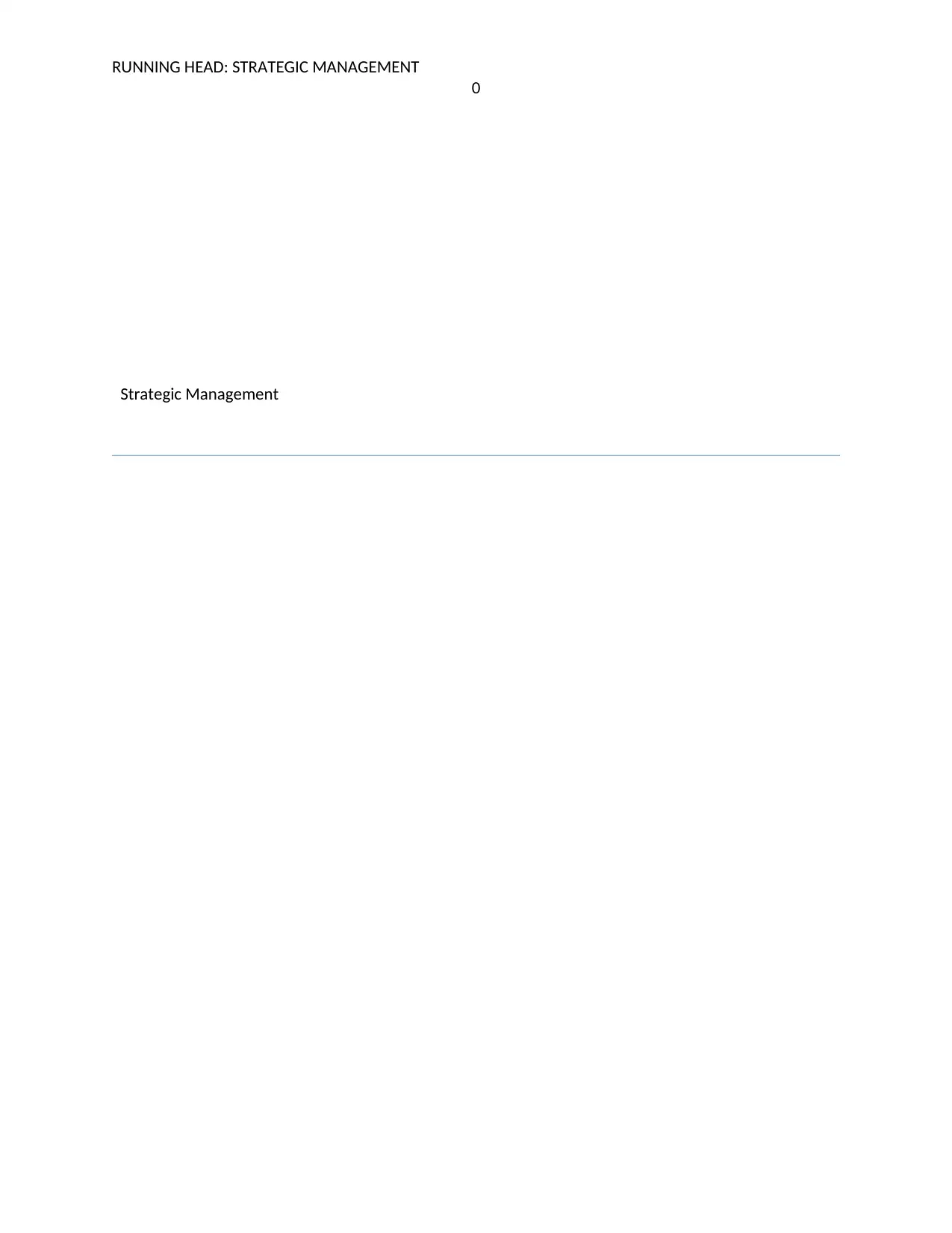
RUNNING HEAD: STRATEGIC MANAGEMENT
0
Strategic Management
0
Strategic Management
Paraphrase This Document
Need a fresh take? Get an instant paraphrase of this document with our AI Paraphraser
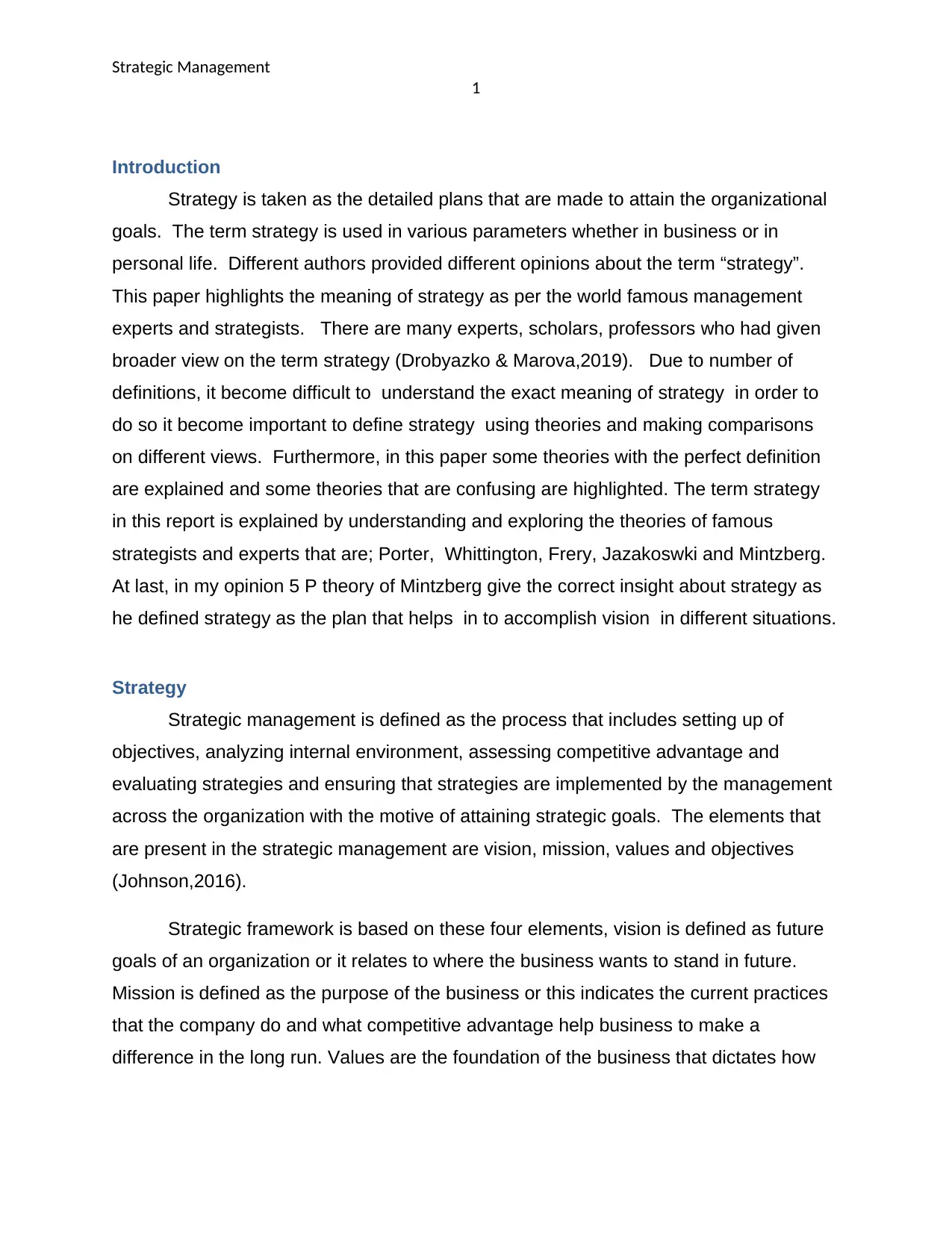
Strategic Management
1
Introduction
Strategy is taken as the detailed plans that are made to attain the organizational
goals. The term strategy is used in various parameters whether in business or in
personal life. Different authors provided different opinions about the term “strategy”.
This paper highlights the meaning of strategy as per the world famous management
experts and strategists. There are many experts, scholars, professors who had given
broader view on the term strategy (Drobyazko & Marova,2019). Due to number of
definitions, it become difficult to understand the exact meaning of strategy in order to
do so it become important to define strategy using theories and making comparisons
on different views. Furthermore, in this paper some theories with the perfect definition
are explained and some theories that are confusing are highlighted. The term strategy
in this report is explained by understanding and exploring the theories of famous
strategists and experts that are; Porter, Whittington, Frery, Jazakoswki and Mintzberg.
At last, in my opinion 5 P theory of Mintzberg give the correct insight about strategy as
he defined strategy as the plan that helps in to accomplish vision in different situations.
Strategy
Strategic management is defined as the process that includes setting up of
objectives, analyzing internal environment, assessing competitive advantage and
evaluating strategies and ensuring that strategies are implemented by the management
across the organization with the motive of attaining strategic goals. The elements that
are present in the strategic management are vision, mission, values and objectives
(Johnson,2016).
Strategic framework is based on these four elements, vision is defined as future
goals of an organization or it relates to where the business wants to stand in future.
Mission is defined as the purpose of the business or this indicates the current practices
that the company do and what competitive advantage help business to make a
difference in the long run. Values are the foundation of the business that dictates how
1
Introduction
Strategy is taken as the detailed plans that are made to attain the organizational
goals. The term strategy is used in various parameters whether in business or in
personal life. Different authors provided different opinions about the term “strategy”.
This paper highlights the meaning of strategy as per the world famous management
experts and strategists. There are many experts, scholars, professors who had given
broader view on the term strategy (Drobyazko & Marova,2019). Due to number of
definitions, it become difficult to understand the exact meaning of strategy in order to
do so it become important to define strategy using theories and making comparisons
on different views. Furthermore, in this paper some theories with the perfect definition
are explained and some theories that are confusing are highlighted. The term strategy
in this report is explained by understanding and exploring the theories of famous
strategists and experts that are; Porter, Whittington, Frery, Jazakoswki and Mintzberg.
At last, in my opinion 5 P theory of Mintzberg give the correct insight about strategy as
he defined strategy as the plan that helps in to accomplish vision in different situations.
Strategy
Strategic management is defined as the process that includes setting up of
objectives, analyzing internal environment, assessing competitive advantage and
evaluating strategies and ensuring that strategies are implemented by the management
across the organization with the motive of attaining strategic goals. The elements that
are present in the strategic management are vision, mission, values and objectives
(Johnson,2016).
Strategic framework is based on these four elements, vision is defined as future
goals of an organization or it relates to where the business wants to stand in future.
Mission is defined as the purpose of the business or this indicates the current practices
that the company do and what competitive advantage help business to make a
difference in the long run. Values are the foundation of the business that dictates how
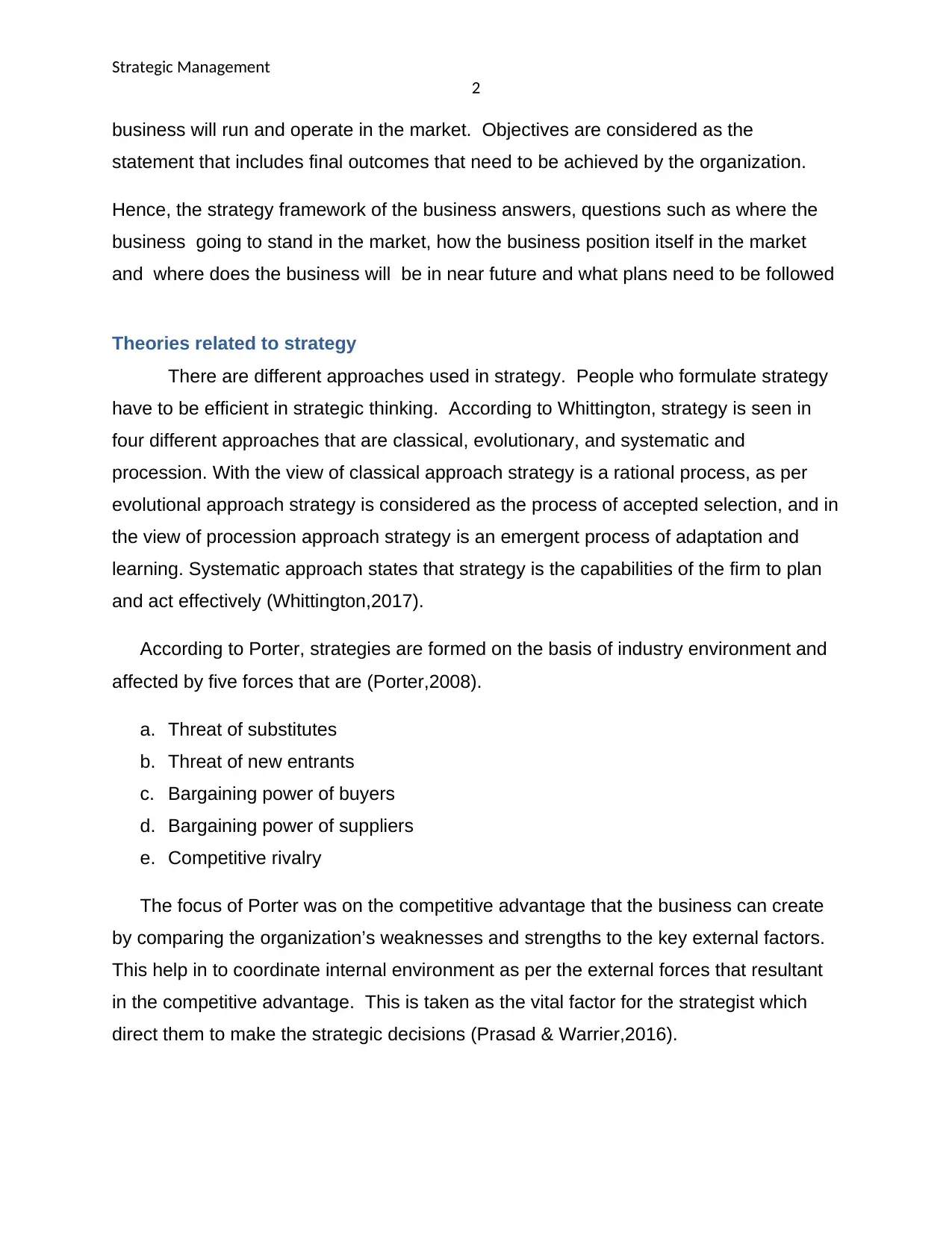
Strategic Management
2
business will run and operate in the market. Objectives are considered as the
statement that includes final outcomes that need to be achieved by the organization.
Hence, the strategy framework of the business answers, questions such as where the
business going to stand in the market, how the business position itself in the market
and where does the business will be in near future and what plans need to be followed
Theories related to strategy
There are different approaches used in strategy. People who formulate strategy
have to be efficient in strategic thinking. According to Whittington, strategy is seen in
four different approaches that are classical, evolutionary, and systematic and
procession. With the view of classical approach strategy is a rational process, as per
evolutional approach strategy is considered as the process of accepted selection, and in
the view of procession approach strategy is an emergent process of adaptation and
learning. Systematic approach states that strategy is the capabilities of the firm to plan
and act effectively (Whittington,2017).
According to Porter, strategies are formed on the basis of industry environment and
affected by five forces that are (Porter,2008).
a. Threat of substitutes
b. Threat of new entrants
c. Bargaining power of buyers
d. Bargaining power of suppliers
e. Competitive rivalry
The focus of Porter was on the competitive advantage that the business can create
by comparing the organization’s weaknesses and strengths to the key external factors.
This help in to coordinate internal environment as per the external forces that resultant
in the competitive advantage. This is taken as the vital factor for the strategist which
direct them to make the strategic decisions (Prasad & Warrier,2016).
2
business will run and operate in the market. Objectives are considered as the
statement that includes final outcomes that need to be achieved by the organization.
Hence, the strategy framework of the business answers, questions such as where the
business going to stand in the market, how the business position itself in the market
and where does the business will be in near future and what plans need to be followed
Theories related to strategy
There are different approaches used in strategy. People who formulate strategy
have to be efficient in strategic thinking. According to Whittington, strategy is seen in
four different approaches that are classical, evolutionary, and systematic and
procession. With the view of classical approach strategy is a rational process, as per
evolutional approach strategy is considered as the process of accepted selection, and in
the view of procession approach strategy is an emergent process of adaptation and
learning. Systematic approach states that strategy is the capabilities of the firm to plan
and act effectively (Whittington,2017).
According to Porter, strategies are formed on the basis of industry environment and
affected by five forces that are (Porter,2008).
a. Threat of substitutes
b. Threat of new entrants
c. Bargaining power of buyers
d. Bargaining power of suppliers
e. Competitive rivalry
The focus of Porter was on the competitive advantage that the business can create
by comparing the organization’s weaknesses and strengths to the key external factors.
This help in to coordinate internal environment as per the external forces that resultant
in the competitive advantage. This is taken as the vital factor for the strategist which
direct them to make the strategic decisions (Prasad & Warrier,2016).
⊘ This is a preview!⊘
Do you want full access?
Subscribe today to unlock all pages.

Trusted by 1+ million students worldwide
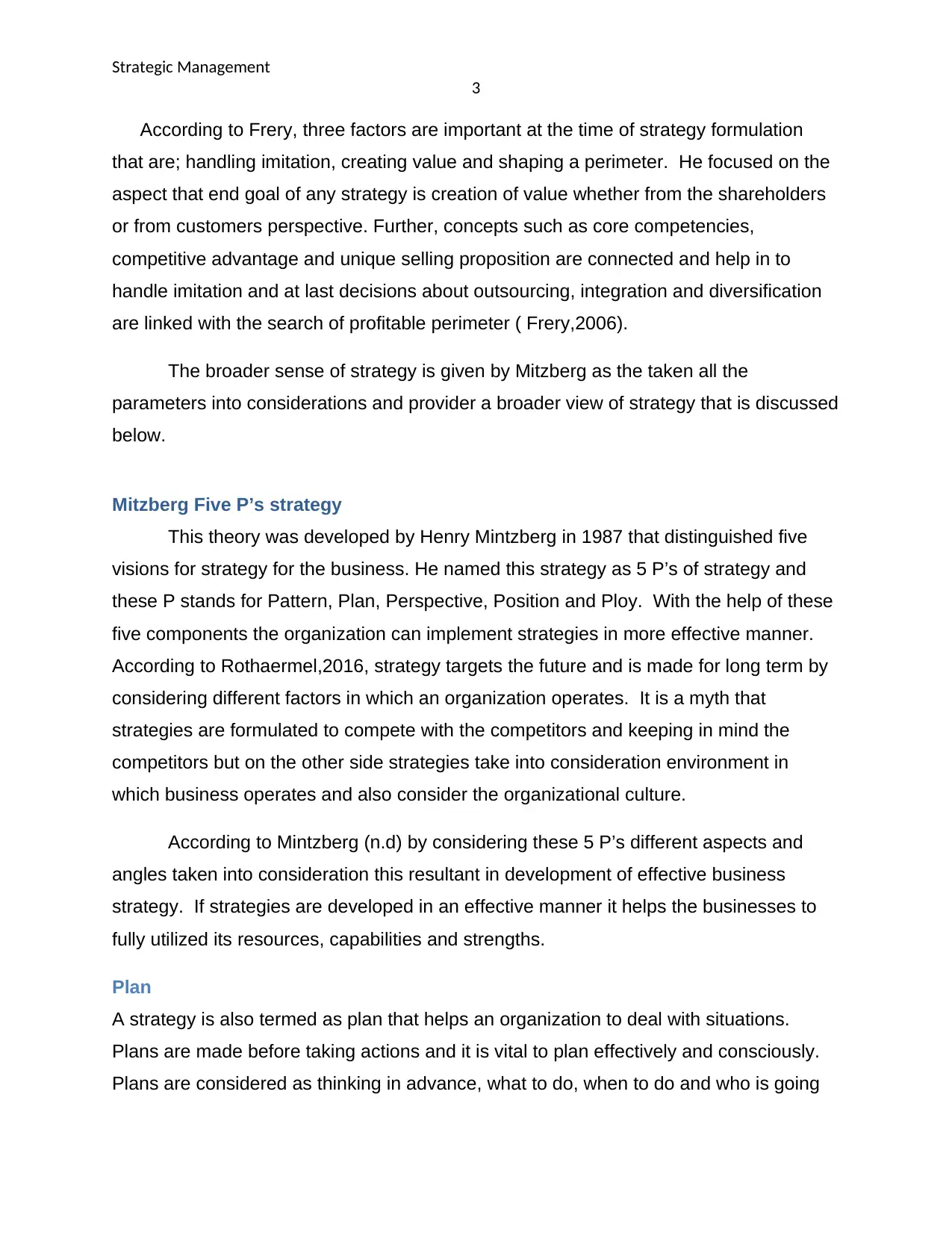
Strategic Management
3
According to Frery, three factors are important at the time of strategy formulation
that are; handling imitation, creating value and shaping a perimeter. He focused on the
aspect that end goal of any strategy is creation of value whether from the shareholders
or from customers perspective. Further, concepts such as core competencies,
competitive advantage and unique selling proposition are connected and help in to
handle imitation and at last decisions about outsourcing, integration and diversification
are linked with the search of profitable perimeter ( Frery,2006).
The broader sense of strategy is given by Mitzberg as the taken all the
parameters into considerations and provider a broader view of strategy that is discussed
below.
Mitzberg Five P’s strategy
This theory was developed by Henry Mintzberg in 1987 that distinguished five
visions for strategy for the business. He named this strategy as 5 P’s of strategy and
these P stands for Pattern, Plan, Perspective, Position and Ploy. With the help of these
five components the organization can implement strategies in more effective manner.
According to Rothaermel,2016, strategy targets the future and is made for long term by
considering different factors in which an organization operates. It is a myth that
strategies are formulated to compete with the competitors and keeping in mind the
competitors but on the other side strategies take into consideration environment in
which business operates and also consider the organizational culture.
According to Mintzberg (n.d) by considering these 5 P’s different aspects and
angles taken into consideration this resultant in development of effective business
strategy. If strategies are developed in an effective manner it helps the businesses to
fully utilized its resources, capabilities and strengths.
Plan
A strategy is also termed as plan that helps an organization to deal with situations.
Plans are made before taking actions and it is vital to plan effectively and consciously.
Plans are considered as thinking in advance, what to do, when to do and who is going
3
According to Frery, three factors are important at the time of strategy formulation
that are; handling imitation, creating value and shaping a perimeter. He focused on the
aspect that end goal of any strategy is creation of value whether from the shareholders
or from customers perspective. Further, concepts such as core competencies,
competitive advantage and unique selling proposition are connected and help in to
handle imitation and at last decisions about outsourcing, integration and diversification
are linked with the search of profitable perimeter ( Frery,2006).
The broader sense of strategy is given by Mitzberg as the taken all the
parameters into considerations and provider a broader view of strategy that is discussed
below.
Mitzberg Five P’s strategy
This theory was developed by Henry Mintzberg in 1987 that distinguished five
visions for strategy for the business. He named this strategy as 5 P’s of strategy and
these P stands for Pattern, Plan, Perspective, Position and Ploy. With the help of these
five components the organization can implement strategies in more effective manner.
According to Rothaermel,2016, strategy targets the future and is made for long term by
considering different factors in which an organization operates. It is a myth that
strategies are formulated to compete with the competitors and keeping in mind the
competitors but on the other side strategies take into consideration environment in
which business operates and also consider the organizational culture.
According to Mintzberg (n.d) by considering these 5 P’s different aspects and
angles taken into consideration this resultant in development of effective business
strategy. If strategies are developed in an effective manner it helps the businesses to
fully utilized its resources, capabilities and strengths.
Plan
A strategy is also termed as plan that helps an organization to deal with situations.
Plans are made before taking actions and it is vital to plan effectively and consciously.
Plans are considered as thinking in advance, what to do, when to do and who is going
Paraphrase This Document
Need a fresh take? Get an instant paraphrase of this document with our AI Paraphraser
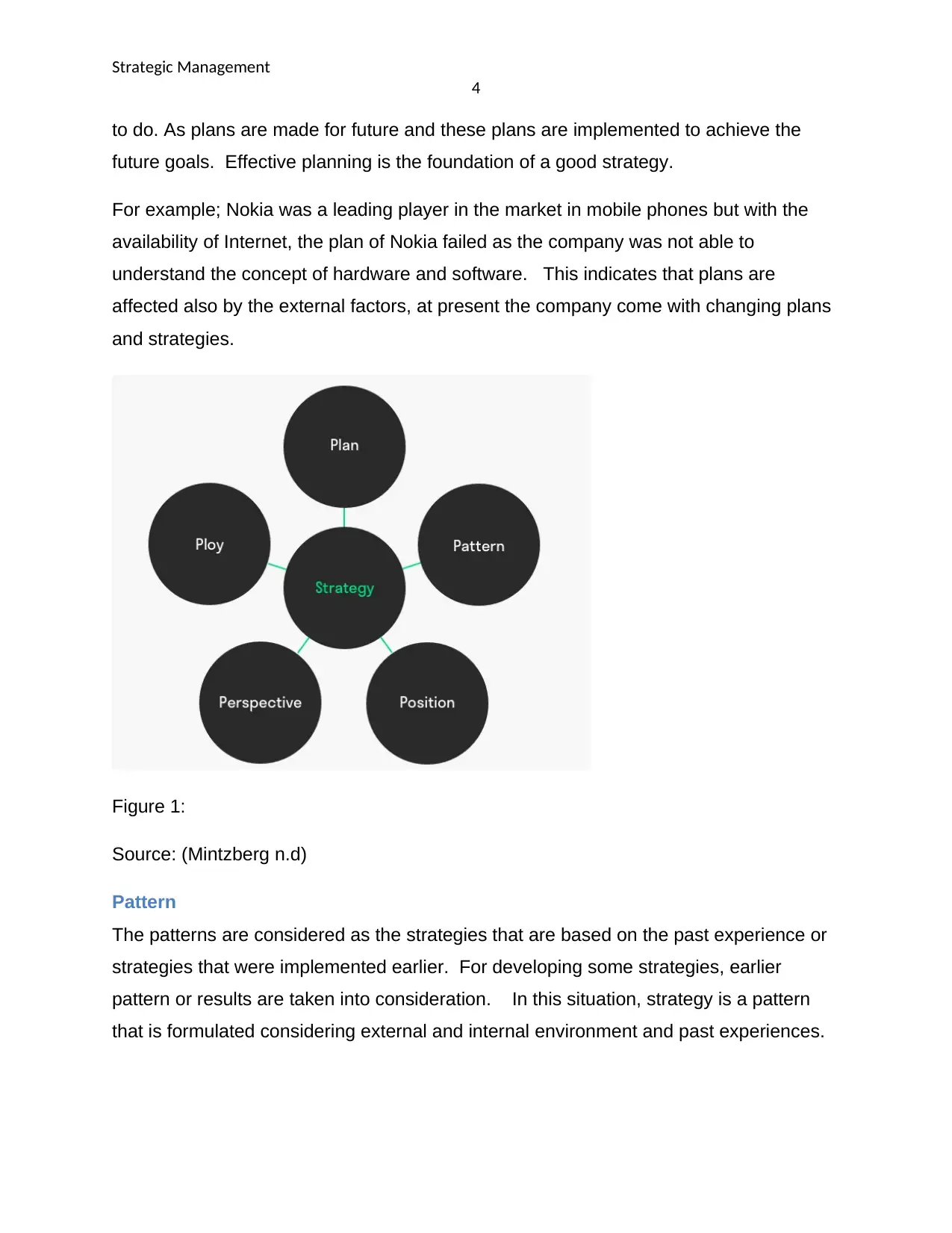
Strategic Management
4
to do. As plans are made for future and these plans are implemented to achieve the
future goals. Effective planning is the foundation of a good strategy.
For example; Nokia was a leading player in the market in mobile phones but with the
availability of Internet, the plan of Nokia failed as the company was not able to
understand the concept of hardware and software. This indicates that plans are
affected also by the external factors, at present the company come with changing plans
and strategies.
Figure 1:
Source: (Mintzberg n.d)
Pattern
The patterns are considered as the strategies that are based on the past experience or
strategies that were implemented earlier. For developing some strategies, earlier
pattern or results are taken into consideration. In this situation, strategy is a pattern
that is formulated considering external and internal environment and past experiences.
4
to do. As plans are made for future and these plans are implemented to achieve the
future goals. Effective planning is the foundation of a good strategy.
For example; Nokia was a leading player in the market in mobile phones but with the
availability of Internet, the plan of Nokia failed as the company was not able to
understand the concept of hardware and software. This indicates that plans are
affected also by the external factors, at present the company come with changing plans
and strategies.
Figure 1:
Source: (Mintzberg n.d)
Pattern
The patterns are considered as the strategies that are based on the past experience or
strategies that were implemented earlier. For developing some strategies, earlier
pattern or results are taken into consideration. In this situation, strategy is a pattern
that is formulated considering external and internal environment and past experiences.
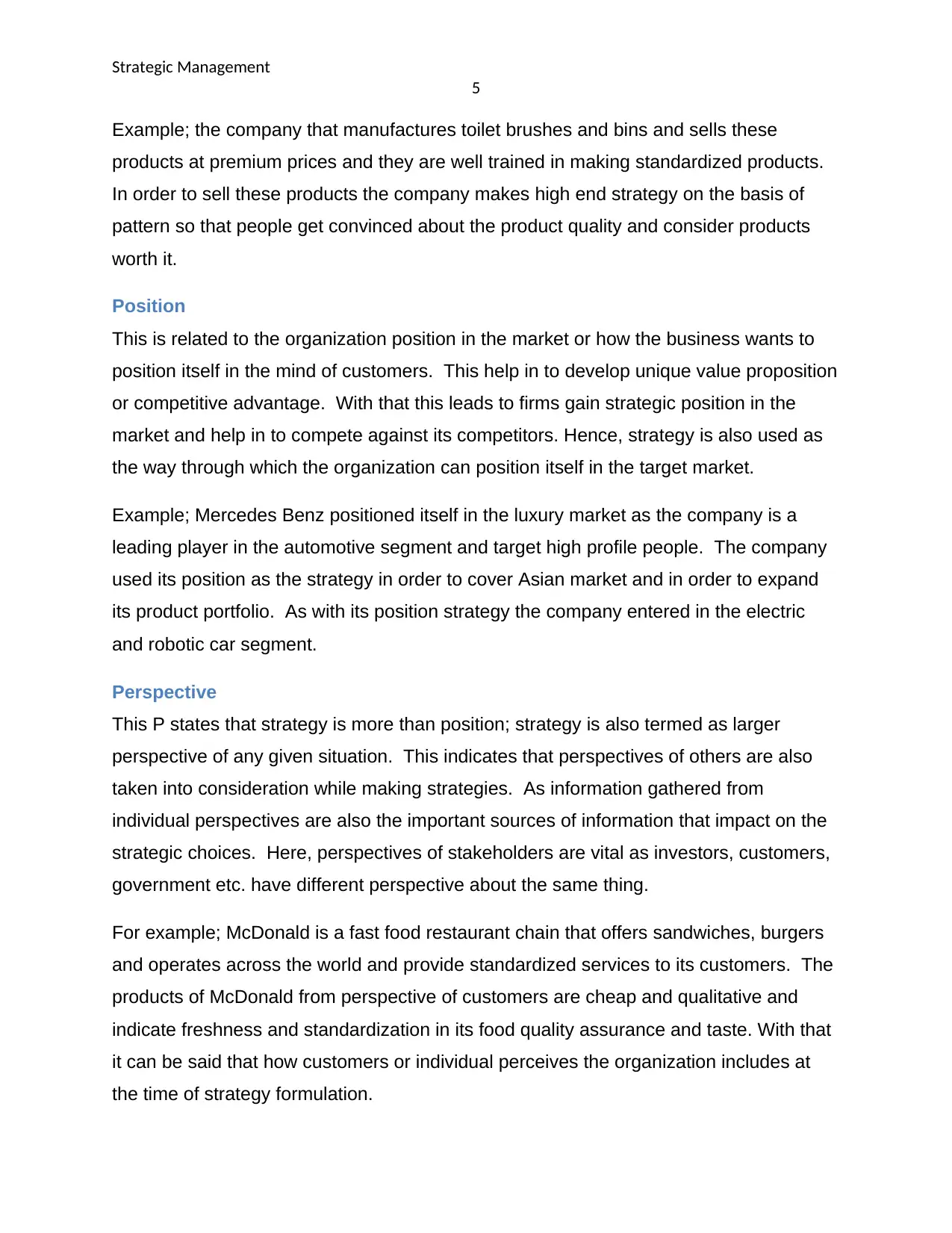
Strategic Management
5
Example; the company that manufactures toilet brushes and bins and sells these
products at premium prices and they are well trained in making standardized products.
In order to sell these products the company makes high end strategy on the basis of
pattern so that people get convinced about the product quality and consider products
worth it.
Position
This is related to the organization position in the market or how the business wants to
position itself in the mind of customers. This help in to develop unique value proposition
or competitive advantage. With that this leads to firms gain strategic position in the
market and help in to compete against its competitors. Hence, strategy is also used as
the way through which the organization can position itself in the target market.
Example; Mercedes Benz positioned itself in the luxury market as the company is a
leading player in the automotive segment and target high profile people. The company
used its position as the strategy in order to cover Asian market and in order to expand
its product portfolio. As with its position strategy the company entered in the electric
and robotic car segment.
Perspective
This P states that strategy is more than position; strategy is also termed as larger
perspective of any given situation. This indicates that perspectives of others are also
taken into consideration while making strategies. As information gathered from
individual perspectives are also the important sources of information that impact on the
strategic choices. Here, perspectives of stakeholders are vital as investors, customers,
government etc. have different perspective about the same thing.
For example; McDonald is a fast food restaurant chain that offers sandwiches, burgers
and operates across the world and provide standardized services to its customers. The
products of McDonald from perspective of customers are cheap and qualitative and
indicate freshness and standardization in its food quality assurance and taste. With that
it can be said that how customers or individual perceives the organization includes at
the time of strategy formulation.
5
Example; the company that manufactures toilet brushes and bins and sells these
products at premium prices and they are well trained in making standardized products.
In order to sell these products the company makes high end strategy on the basis of
pattern so that people get convinced about the product quality and consider products
worth it.
Position
This is related to the organization position in the market or how the business wants to
position itself in the mind of customers. This help in to develop unique value proposition
or competitive advantage. With that this leads to firms gain strategic position in the
market and help in to compete against its competitors. Hence, strategy is also used as
the way through which the organization can position itself in the target market.
Example; Mercedes Benz positioned itself in the luxury market as the company is a
leading player in the automotive segment and target high profile people. The company
used its position as the strategy in order to cover Asian market and in order to expand
its product portfolio. As with its position strategy the company entered in the electric
and robotic car segment.
Perspective
This P states that strategy is more than position; strategy is also termed as larger
perspective of any given situation. This indicates that perspectives of others are also
taken into consideration while making strategies. As information gathered from
individual perspectives are also the important sources of information that impact on the
strategic choices. Here, perspectives of stakeholders are vital as investors, customers,
government etc. have different perspective about the same thing.
For example; McDonald is a fast food restaurant chain that offers sandwiches, burgers
and operates across the world and provide standardized services to its customers. The
products of McDonald from perspective of customers are cheap and qualitative and
indicate freshness and standardization in its food quality assurance and taste. With that
it can be said that how customers or individual perceives the organization includes at
the time of strategy formulation.
⊘ This is a preview!⊘
Do you want full access?
Subscribe today to unlock all pages.

Trusted by 1+ million students worldwide
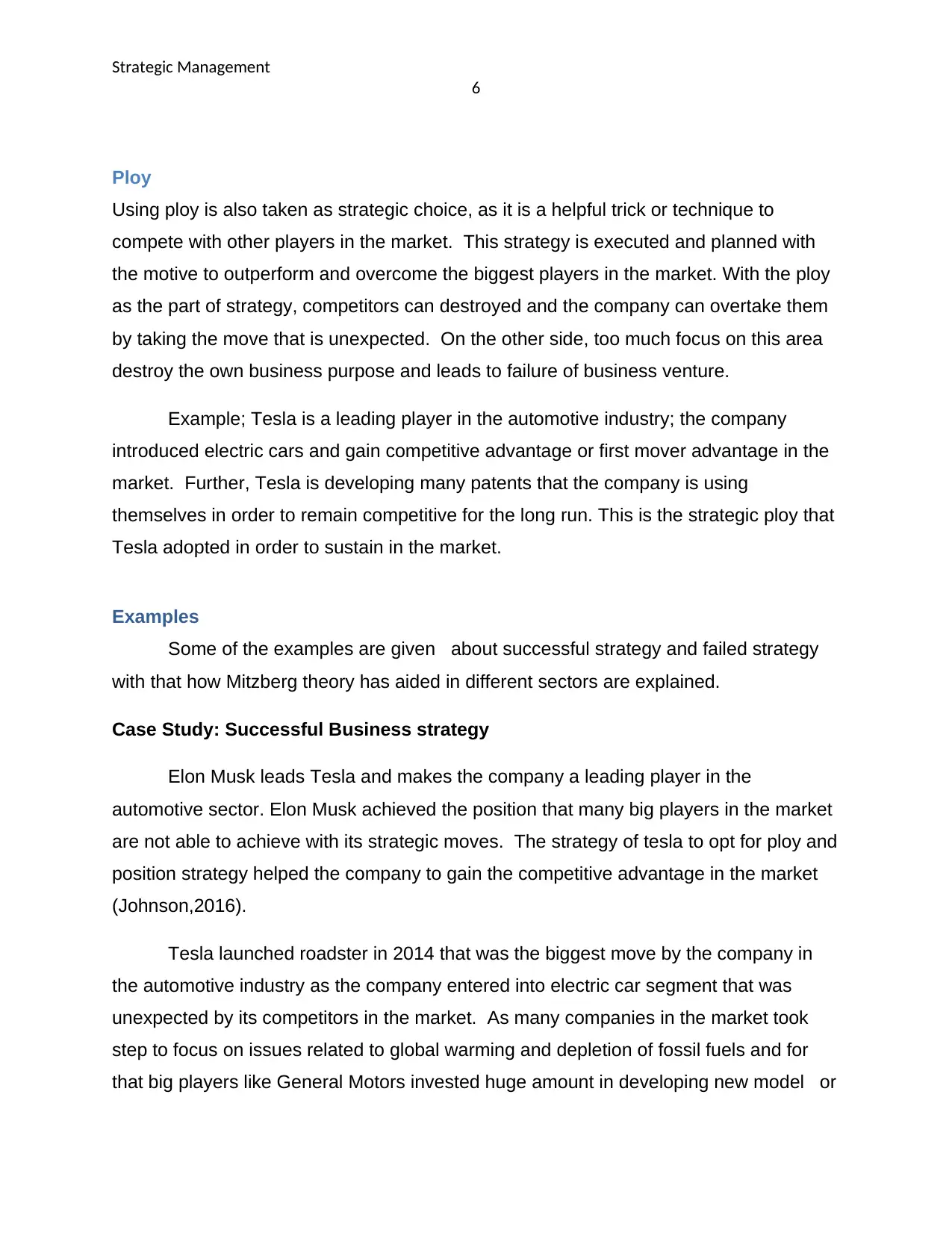
Strategic Management
6
Ploy
Using ploy is also taken as strategic choice, as it is a helpful trick or technique to
compete with other players in the market. This strategy is executed and planned with
the motive to outperform and overcome the biggest players in the market. With the ploy
as the part of strategy, competitors can destroyed and the company can overtake them
by taking the move that is unexpected. On the other side, too much focus on this area
destroy the own business purpose and leads to failure of business venture.
Example; Tesla is a leading player in the automotive industry; the company
introduced electric cars and gain competitive advantage or first mover advantage in the
market. Further, Tesla is developing many patents that the company is using
themselves in order to remain competitive for the long run. This is the strategic ploy that
Tesla adopted in order to sustain in the market.
Examples
Some of the examples are given about successful strategy and failed strategy
with that how Mitzberg theory has aided in different sectors are explained.
Case Study: Successful Business strategy
Elon Musk leads Tesla and makes the company a leading player in the
automotive sector. Elon Musk achieved the position that many big players in the market
are not able to achieve with its strategic moves. The strategy of tesla to opt for ploy and
position strategy helped the company to gain the competitive advantage in the market
(Johnson,2016).
Tesla launched roadster in 2014 that was the biggest move by the company in
the automotive industry as the company entered into electric car segment that was
unexpected by its competitors in the market. As many companies in the market took
step to focus on issues related to global warming and depletion of fossil fuels and for
that big players like General Motors invested huge amount in developing new model or
6
Ploy
Using ploy is also taken as strategic choice, as it is a helpful trick or technique to
compete with other players in the market. This strategy is executed and planned with
the motive to outperform and overcome the biggest players in the market. With the ploy
as the part of strategy, competitors can destroyed and the company can overtake them
by taking the move that is unexpected. On the other side, too much focus on this area
destroy the own business purpose and leads to failure of business venture.
Example; Tesla is a leading player in the automotive industry; the company
introduced electric cars and gain competitive advantage or first mover advantage in the
market. Further, Tesla is developing many patents that the company is using
themselves in order to remain competitive for the long run. This is the strategic ploy that
Tesla adopted in order to sustain in the market.
Examples
Some of the examples are given about successful strategy and failed strategy
with that how Mitzberg theory has aided in different sectors are explained.
Case Study: Successful Business strategy
Elon Musk leads Tesla and makes the company a leading player in the
automotive sector. Elon Musk achieved the position that many big players in the market
are not able to achieve with its strategic moves. The strategy of tesla to opt for ploy and
position strategy helped the company to gain the competitive advantage in the market
(Johnson,2016).
Tesla launched roadster in 2014 that was the biggest move by the company in
the automotive industry as the company entered into electric car segment that was
unexpected by its competitors in the market. As many companies in the market took
step to focus on issues related to global warming and depletion of fossil fuels and for
that big players like General Motors invested huge amount in developing new model or
Paraphrase This Document
Need a fresh take? Get an instant paraphrase of this document with our AI Paraphraser
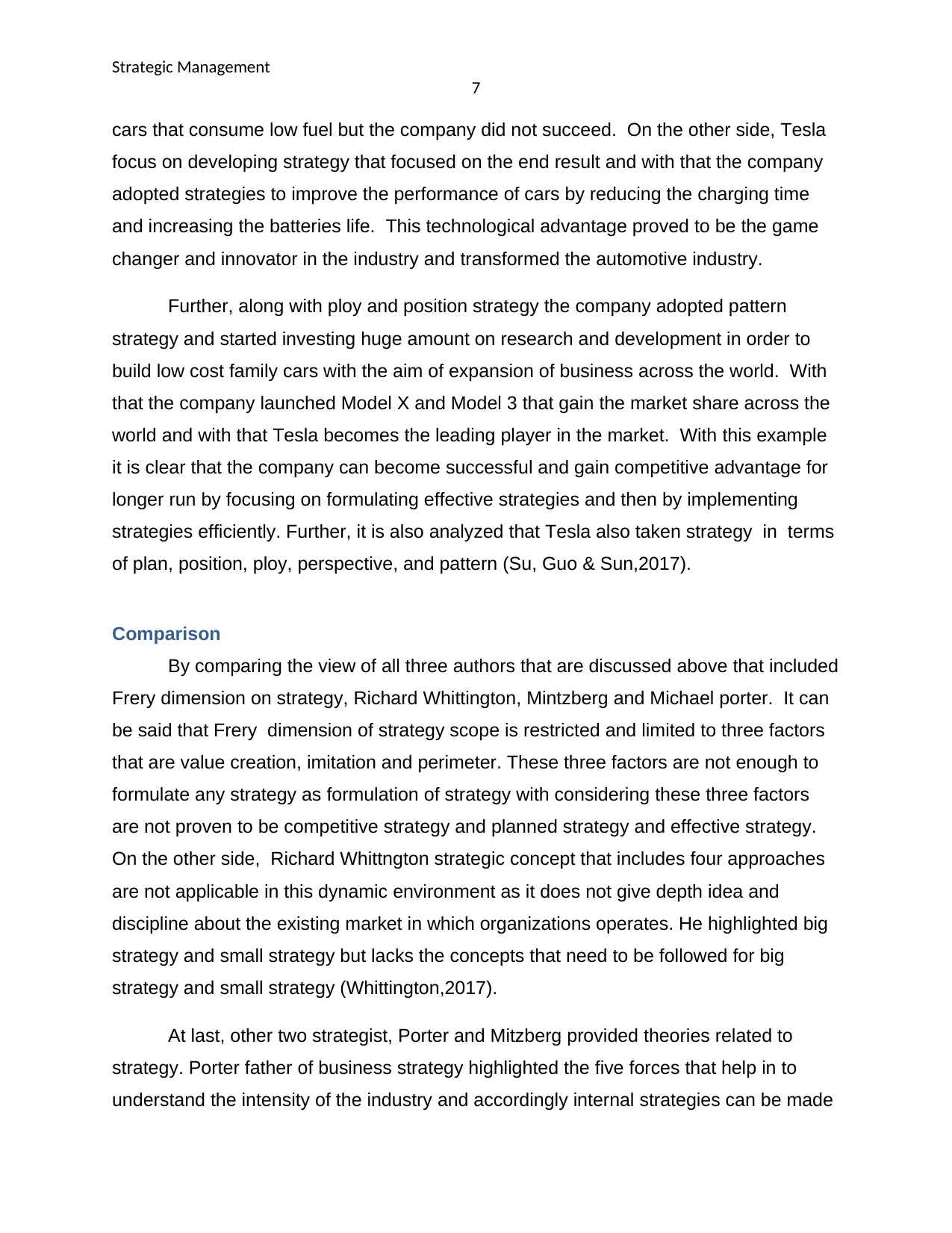
Strategic Management
7
cars that consume low fuel but the company did not succeed. On the other side, Tesla
focus on developing strategy that focused on the end result and with that the company
adopted strategies to improve the performance of cars by reducing the charging time
and increasing the batteries life. This technological advantage proved to be the game
changer and innovator in the industry and transformed the automotive industry.
Further, along with ploy and position strategy the company adopted pattern
strategy and started investing huge amount on research and development in order to
build low cost family cars with the aim of expansion of business across the world. With
that the company launched Model X and Model 3 that gain the market share across the
world and with that Tesla becomes the leading player in the market. With this example
it is clear that the company can become successful and gain competitive advantage for
longer run by focusing on formulating effective strategies and then by implementing
strategies efficiently. Further, it is also analyzed that Tesla also taken strategy in terms
of plan, position, ploy, perspective, and pattern (Su, Guo & Sun,2017).
Comparison
By comparing the view of all three authors that are discussed above that included
Frery dimension on strategy, Richard Whittington, Mintzberg and Michael porter. It can
be said that Frery dimension of strategy scope is restricted and limited to three factors
that are value creation, imitation and perimeter. These three factors are not enough to
formulate any strategy as formulation of strategy with considering these three factors
are not proven to be competitive strategy and planned strategy and effective strategy.
On the other side, Richard Whittngton strategic concept that includes four approaches
are not applicable in this dynamic environment as it does not give depth idea and
discipline about the existing market in which organizations operates. He highlighted big
strategy and small strategy but lacks the concepts that need to be followed for big
strategy and small strategy (Whittington,2017).
At last, other two strategist, Porter and Mitzberg provided theories related to
strategy. Porter father of business strategy highlighted the five forces that help in to
understand the intensity of the industry and accordingly internal strategies can be made
7
cars that consume low fuel but the company did not succeed. On the other side, Tesla
focus on developing strategy that focused on the end result and with that the company
adopted strategies to improve the performance of cars by reducing the charging time
and increasing the batteries life. This technological advantage proved to be the game
changer and innovator in the industry and transformed the automotive industry.
Further, along with ploy and position strategy the company adopted pattern
strategy and started investing huge amount on research and development in order to
build low cost family cars with the aim of expansion of business across the world. With
that the company launched Model X and Model 3 that gain the market share across the
world and with that Tesla becomes the leading player in the market. With this example
it is clear that the company can become successful and gain competitive advantage for
longer run by focusing on formulating effective strategies and then by implementing
strategies efficiently. Further, it is also analyzed that Tesla also taken strategy in terms
of plan, position, ploy, perspective, and pattern (Su, Guo & Sun,2017).
Comparison
By comparing the view of all three authors that are discussed above that included
Frery dimension on strategy, Richard Whittington, Mintzberg and Michael porter. It can
be said that Frery dimension of strategy scope is restricted and limited to three factors
that are value creation, imitation and perimeter. These three factors are not enough to
formulate any strategy as formulation of strategy with considering these three factors
are not proven to be competitive strategy and planned strategy and effective strategy.
On the other side, Richard Whittngton strategic concept that includes four approaches
are not applicable in this dynamic environment as it does not give depth idea and
discipline about the existing market in which organizations operates. He highlighted big
strategy and small strategy but lacks the concepts that need to be followed for big
strategy and small strategy (Whittington,2017).
At last, other two strategist, Porter and Mitzberg provided theories related to
strategy. Porter father of business strategy highlighted the five forces that help in to
understand the intensity of the industry and accordingly internal strategies can be made
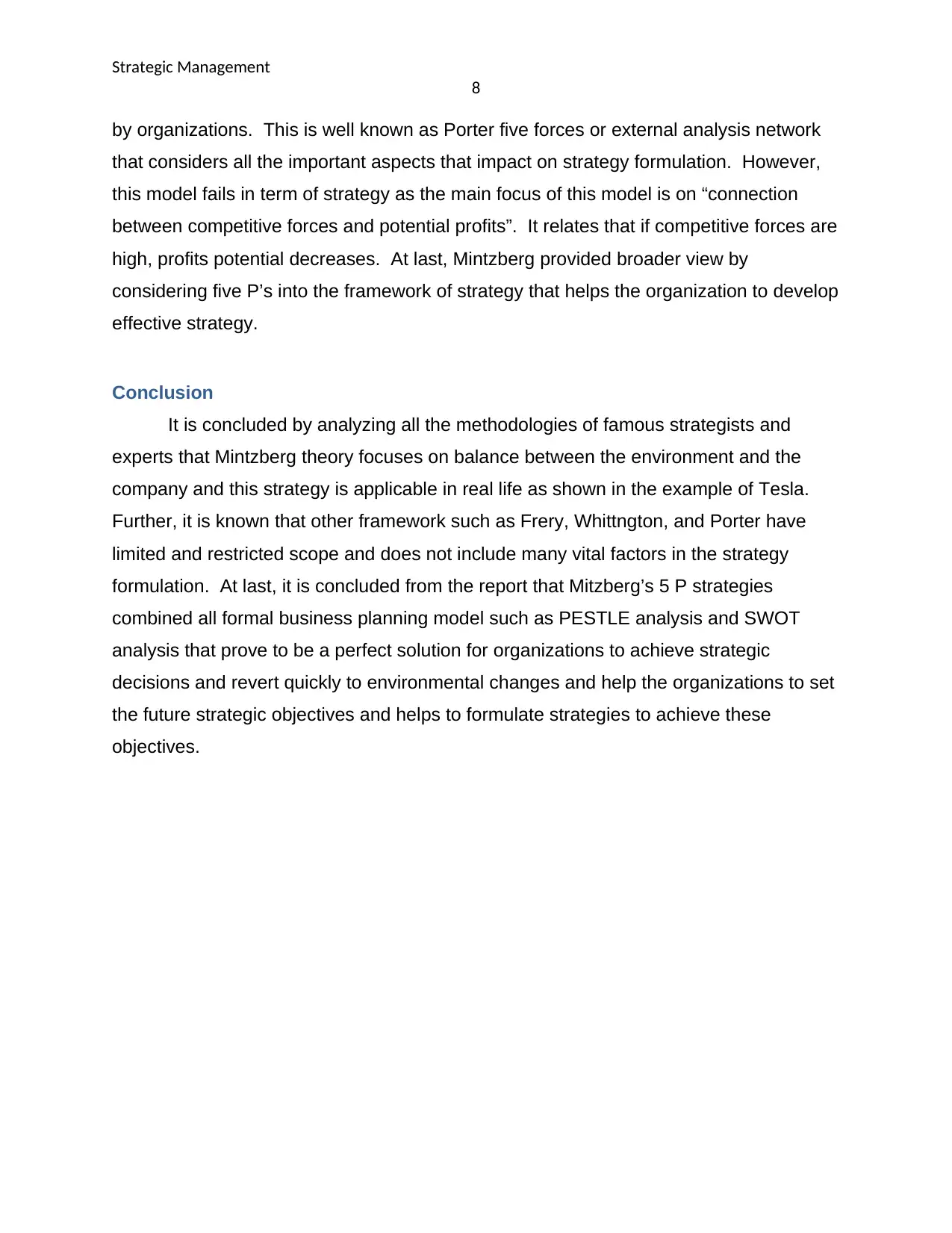
Strategic Management
8
by organizations. This is well known as Porter five forces or external analysis network
that considers all the important aspects that impact on strategy formulation. However,
this model fails in term of strategy as the main focus of this model is on “connection
between competitive forces and potential profits”. It relates that if competitive forces are
high, profits potential decreases. At last, Mintzberg provided broader view by
considering five P’s into the framework of strategy that helps the organization to develop
effective strategy.
Conclusion
It is concluded by analyzing all the methodologies of famous strategists and
experts that Mintzberg theory focuses on balance between the environment and the
company and this strategy is applicable in real life as shown in the example of Tesla.
Further, it is known that other framework such as Frery, Whittngton, and Porter have
limited and restricted scope and does not include many vital factors in the strategy
formulation. At last, it is concluded from the report that Mitzberg’s 5 P strategies
combined all formal business planning model such as PESTLE analysis and SWOT
analysis that prove to be a perfect solution for organizations to achieve strategic
decisions and revert quickly to environmental changes and help the organizations to set
the future strategic objectives and helps to formulate strategies to achieve these
objectives.
8
by organizations. This is well known as Porter five forces or external analysis network
that considers all the important aspects that impact on strategy formulation. However,
this model fails in term of strategy as the main focus of this model is on “connection
between competitive forces and potential profits”. It relates that if competitive forces are
high, profits potential decreases. At last, Mintzberg provided broader view by
considering five P’s into the framework of strategy that helps the organization to develop
effective strategy.
Conclusion
It is concluded by analyzing all the methodologies of famous strategists and
experts that Mintzberg theory focuses on balance between the environment and the
company and this strategy is applicable in real life as shown in the example of Tesla.
Further, it is known that other framework such as Frery, Whittngton, and Porter have
limited and restricted scope and does not include many vital factors in the strategy
formulation. At last, it is concluded from the report that Mitzberg’s 5 P strategies
combined all formal business planning model such as PESTLE analysis and SWOT
analysis that prove to be a perfect solution for organizations to achieve strategic
decisions and revert quickly to environmental changes and help the organizations to set
the future strategic objectives and helps to formulate strategies to achieve these
objectives.
⊘ This is a preview!⊘
Do you want full access?
Subscribe today to unlock all pages.

Trusted by 1+ million students worldwide
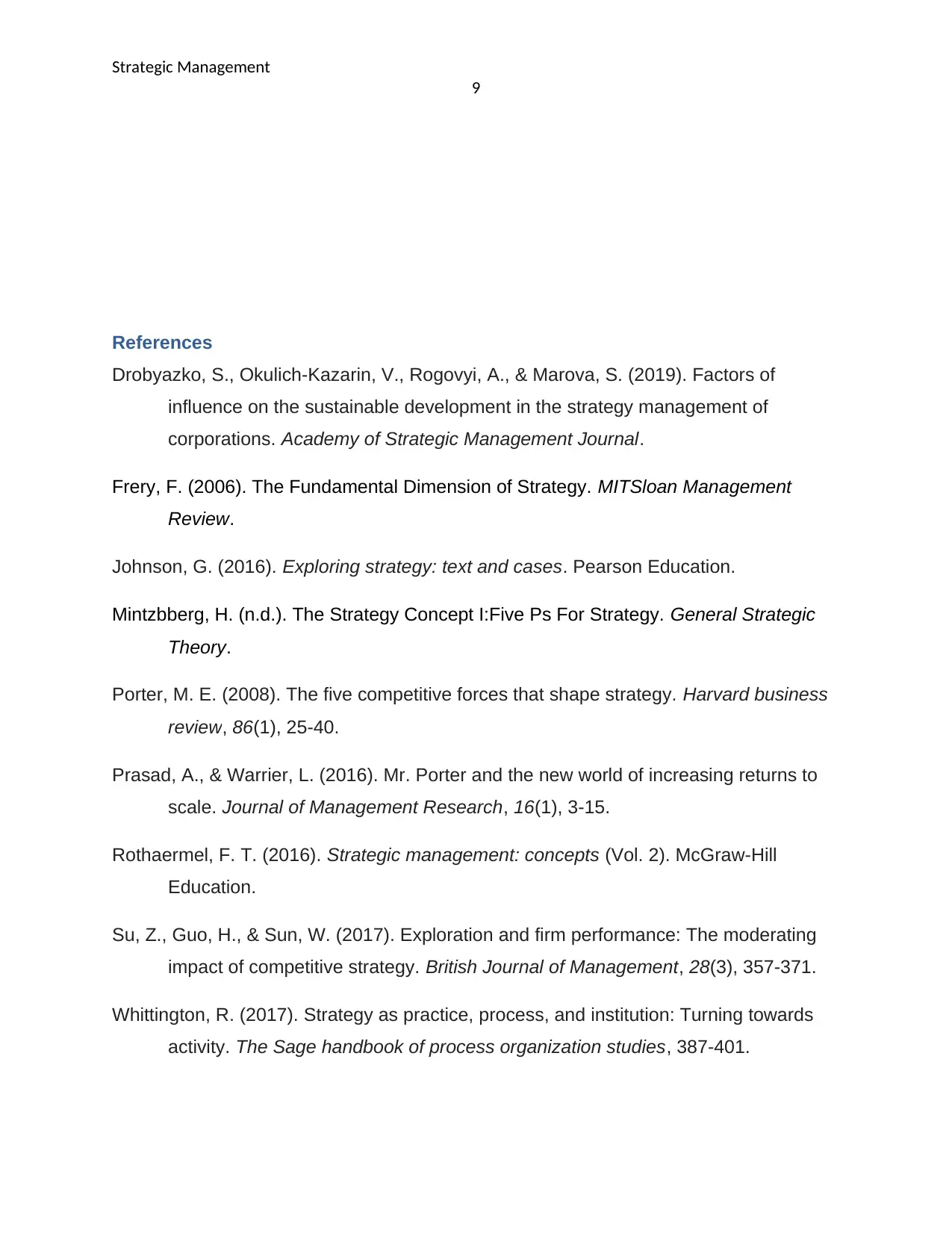
Strategic Management
9
References
Drobyazko, S., Okulich-Kazarin, V., Rogovyi, A., & Marova, S. (2019). Factors of
influence on the sustainable development in the strategy management of
corporations. Academy of Strategic Management Journal.
Frery, F. (2006). The Fundamental Dimension of Strategy. MITSloan Management
Review.
Johnson, G. (2016). Exploring strategy: text and cases. Pearson Education.
Mintzbberg, H. (n.d.). The Strategy Concept I:Five Ps For Strategy. General Strategic
Theory.
Porter, M. E. (2008). The five competitive forces that shape strategy. Harvard business
review, 86(1), 25-40.
Prasad, A., & Warrier, L. (2016). Mr. Porter and the new world of increasing returns to
scale. Journal of Management Research, 16(1), 3-15.
Rothaermel, F. T. (2016). Strategic management: concepts (Vol. 2). McGraw-Hill
Education.
Su, Z., Guo, H., & Sun, W. (2017). Exploration and firm performance: The moderating
impact of competitive strategy. British Journal of Management, 28(3), 357-371.
Whittington, R. (2017). Strategy as practice, process, and institution: Turning towards
activity. The Sage handbook of process organization studies, 387-401.
9
References
Drobyazko, S., Okulich-Kazarin, V., Rogovyi, A., & Marova, S. (2019). Factors of
influence on the sustainable development in the strategy management of
corporations. Academy of Strategic Management Journal.
Frery, F. (2006). The Fundamental Dimension of Strategy. MITSloan Management
Review.
Johnson, G. (2016). Exploring strategy: text and cases. Pearson Education.
Mintzbberg, H. (n.d.). The Strategy Concept I:Five Ps For Strategy. General Strategic
Theory.
Porter, M. E. (2008). The five competitive forces that shape strategy. Harvard business
review, 86(1), 25-40.
Prasad, A., & Warrier, L. (2016). Mr. Porter and the new world of increasing returns to
scale. Journal of Management Research, 16(1), 3-15.
Rothaermel, F. T. (2016). Strategic management: concepts (Vol. 2). McGraw-Hill
Education.
Su, Z., Guo, H., & Sun, W. (2017). Exploration and firm performance: The moderating
impact of competitive strategy. British Journal of Management, 28(3), 357-371.
Whittington, R. (2017). Strategy as practice, process, and institution: Turning towards
activity. The Sage handbook of process organization studies, 387-401.
1 out of 10
Related Documents
Your All-in-One AI-Powered Toolkit for Academic Success.
+13062052269
info@desklib.com
Available 24*7 on WhatsApp / Email
![[object Object]](/_next/static/media/star-bottom.7253800d.svg)
Unlock your academic potential
Copyright © 2020–2025 A2Z Services. All Rights Reserved. Developed and managed by ZUCOL.





